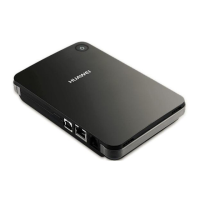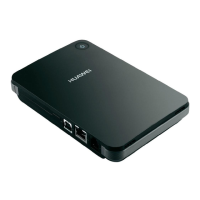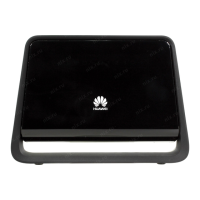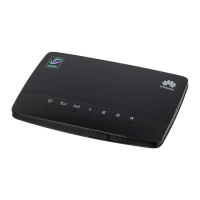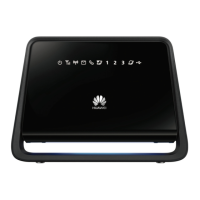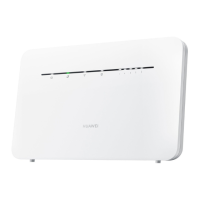Do you have a question about the Huawei B2268H and is the answer not in the manual?
General introduction to the LTE device, its components, and security features.
Examples of how the LTE device can be used for internet access.
Usage of the wireless LAN button for on/off and WPS.
Methods for managing the LTE device, primarily via web configurator.
Recommended practices for device security and effective management.
Explanation of the LEDs on the device and Ethernet ports.
Instructions on how to reset the device to factory defaults.
Introduction to the web-based device setup and management interface.
Description of the main components of the web configurator interface.
How to view network traffic status and statistics.
How to configure system passwords for different user accounts.
Summary of the navigation panel links and their functions.
Overview of screens showing device and client connection status.
Viewing network connection status of the device and its clients.
Displaying device system resources, interfaces, and SIP accounts.
Configuring the LTE device for internet access via WAN connection.
Viewing and modifying the WAN interface settings.
Configuration screen for a WAN connection.
Specifying the PIN for the SIM card.
Introduction to setting up the LTE device's wireless connection.
Enabling WLAN, setting SSID, and selecting security mode.
Configuring WEP encryption for wireless network security.
Setting up WPA/WPA2-PSK for improved wireless security.
Information on WPA2 and WPA security modes.
Configuring multiple wireless network names (SSIDs).
Configuring WiFi Protected Setup (WPS) for quick wireless connection.
Enabling or disabling WiFi MultiMedia (WMM) for applications.
Configuring when the LTE Device enables or disables the wireless LAN.
In-depth discussion of wireless LANs.
General overview of wireless network security standards and importance.
Configuration and security aspects of Service Set Identifiers (SSIDs).
Filtering access based on device MAC addresses.
Detailed explanation of WPS setup and its functionality.
Discusses the limitations and potential security issues of WPS.
Introduction to Local Area Network (LAN) and IP address management.
Configuring LAN IP address, subnet mask, and DNS server.
Assigning IP addresses to specific computers based on MAC addresses.
Configuring UPnP settings on the LTE Device.
Setting up file sharing for USB storage devices.
Using the LTE Device as a DLNA-compliant media server.
Introduction to routing outbound traffic and using static routes.
Viewing and configuring IPv4 static routes on the LTE Device.
Screen for configuring individual static route entries.
Explanation of Network Address Translation (NAT) and its purpose.
Forwarding incoming service requests to local servers.
Setting the IP address for the network DMZ host.
Limiting concurrent NAT sessions per client.
Enabling or disabling SIP Application Layer Gateway (ALG).
Background information on NAT topics.
Configuring the LTE device to use Dynamic DNS services.
Screen for enabling and configuring DDNS settings on the LTE Device.
Enabling and configuring the firewall for device and network protection.
Enabling or disabling the LTE Device's firewall.
Viewing the configured service list for firewall rules.
Managing incoming or outgoing filtering rules.
Creating or editing access control list (ACL) rules.
Enabling or disabling Denial of Service (DoS) protection.
Background information on firewall topics.
Introduction to MAC address filtering for client access control.
Allowing or denying wireless and LAN client access via MAC filtering.
Blocking web sites and defining time periods for parental control.
Enabling parental control, viewing rules, and schedules.
Configuring restricted access schedules and URL filtering.
Introduction to using Voice over IP (VoIP) features on the LTE Device.
Configuring SIP server information and dialing plans.
Enabling and configuring SIP accounts and mapping them to phone ports.
Maintaining settings based on the LTE Device's geographical region.
Adding, editing, or removing speed-dial numbers for outgoing calls.
Background material relevant to VoIP screens.
Viewing LTE related signaling status.
Configuring where the LTE Device sends logs and which logs are recorded.
Viewing system logs filtered by severity level.
Viewing phone logs and alert messages.
Viewing call records for VoIP calls made or received.
Looking at network traffic status for WAN, LAN, and NAT.
Viewing WAN traffic statistics.
Viewing LAN traffic statistics.
Viewing NAT status for the LTE Device's clients.
Viewing VoIP traffic statistics.
Configuring system passwords for different user accounts.
Screen for configuring system password.
Managing the LTE Device from a remote location.
Deciding which services to access which LTE Device interface.
Configuring host name, domain name, and inactivity time-out.
Screen for configuring system's host name, domain name, and inactivity time-out.
Configuring the system's time and date.
Screen for configuring LTE Device's time based on local time zone.
Configuring where the LTE Device sends logs and which logs are recorded.
Screen for configuring LTE Device's log settings.
Explanation of how to upload new firmware to the LTE Device.
Details on Firmware Update Over The Air (FOTA) process.
Process of uploading new firmware via HTTP.
Backing up and restoring device configurations, and resetting to defaults.
Screen for managing backups, restores, and factory defaults.
Remotely rebooting the LTE Device without turning off power.
Using diagnostic methods to test connections and view detailed information.
Checking host availability and troubleshooting network connections.
Suggestions for solving common problems encountered with the LTE Device.
Troubleshooting issues related to power, hardware, and LED indicators.
Troubleshooting problems with accessing and logging into the LTE Device.
Troubleshooting issues related to accessing the Internet.
Troubleshooting intermittent or unstable wireless connections.
Troubleshooting issues with phone ports and VoIP calls.
Troubleshooting UPnP detection and application issues.
General introduction to the LTE device, its components, and security features.
Examples of how the LTE device can be used for internet access.
Usage of the wireless LAN button for on/off and WPS.
Methods for managing the LTE device, primarily via web configurator.
Recommended practices for device security and effective management.
Explanation of the LEDs on the device and Ethernet ports.
Instructions on how to reset the device to factory defaults.
Introduction to the web-based device setup and management interface.
Description of the main components of the web configurator interface.
How to view network traffic status and statistics.
How to configure system passwords for different user accounts.
Summary of the navigation panel links and their functions.
Overview of screens showing device and client connection status.
Viewing network connection status of the device and its clients.
Displaying device system resources, interfaces, and SIP accounts.
Configuring the LTE device for internet access via WAN connection.
Viewing and modifying the WAN interface settings.
Configuration screen for a WAN connection.
Specifying the PIN for the SIM card.
Introduction to setting up the LTE device's wireless connection.
Enabling WLAN, setting SSID, and selecting security mode.
Configuring WEP encryption for wireless network security.
Setting up WPA/WPA2-PSK for improved wireless security.
Information on WPA2 and WPA security modes.
Configuring multiple wireless network names (SSIDs).
Configuring WiFi Protected Setup (WPS) for quick wireless connection.
Enabling or disabling WiFi MultiMedia (WMM) for applications.
Configuring when the LTE Device enables or disables the wireless LAN.
In-depth discussion of wireless LANs.
General overview of wireless network security standards and importance.
Configuration and security aspects of Service Set Identifiers (SSIDs).
Filtering access based on device MAC addresses.
Detailed explanation of WPS setup and its functionality.
Discusses the limitations and potential security issues of WPS.
Introduction to Local Area Network (LAN) and IP address management.
Configuring LAN IP address, subnet mask, and DNS server.
Assigning IP addresses to specific computers based on MAC addresses.
Configuring UPnP settings on the LTE Device.
Setting up file sharing for USB storage devices.
Using the LTE Device as a DLNA-compliant media server.
Introduction to routing outbound traffic and using static routes.
Viewing and configuring IPv4 static routes on the LTE Device.
Screen for configuring individual static route entries.
Explanation of Network Address Translation (NAT) and its purpose.
Forwarding incoming service requests to local servers.
Setting the IP address for the network DMZ host.
Limiting concurrent NAT sessions per client.
Enabling or disabling SIP Application Layer Gateway (ALG).
Background information on NAT topics.
Configuring the LTE device to use Dynamic DNS services.
Screen for enabling and configuring DDNS settings on the LTE Device.
Enabling and configuring the firewall for device and network protection.
Enabling or disabling the LTE Device's firewall.
Viewing the configured service list for firewall rules.
Managing incoming or outgoing filtering rules.
Creating or editing access control list (ACL) rules.
Enabling or disabling Denial of Service (DoS) protection.
Background information on firewall topics.
Introduction to MAC address filtering for client access control.
Allowing or denying wireless and LAN client access via MAC filtering.
Blocking web sites and defining time periods for parental control.
Enabling parental control, viewing rules, and schedules.
Configuring restricted access schedules and URL filtering.
Introduction to using Voice over IP (VoIP) features on the LTE Device.
Configuring SIP server information and dialing plans.
Enabling and configuring SIP accounts and mapping them to phone ports.
Maintaining settings based on the LTE Device's geographical region.
Adding, editing, or removing speed-dial numbers for outgoing calls.
Background material relevant to VoIP screens.
Viewing LTE related signaling status.
Configuring where the LTE Device sends logs and which logs are recorded.
Viewing system logs filtered by severity level.
Viewing phone logs and alert messages.
Viewing call records for VoIP calls made or received.
Looking at network traffic status for WAN, LAN, and NAT.
Viewing WAN traffic statistics.
Viewing LAN traffic statistics.
Viewing NAT status for the LTE Device's clients.
Viewing VoIP traffic statistics.
Configuring system passwords for different user accounts.
Screen for configuring system password.
Managing the LTE Device from a remote location.
Deciding which services to access which LTE Device interface.
Configuring host name, domain name, and inactivity time-out.
Screen for configuring system's host name, domain name, and inactivity time-out.
Configuring the system's time and date.
Screen for configuring LTE Device's time based on local time zone.
Configuring where the LTE Device sends logs and which logs are recorded.
Screen for configuring LTE Device's log settings.
Explanation of how to upload new firmware to the LTE Device.
Details on Firmware Update Over The Air (FOTA) process.
Process of uploading new firmware via HTTP.
Backing up and restoring device configurations, and resetting to defaults.
Screen for managing backups, restores, and factory defaults.
Remotely rebooting the LTE Device without turning off power.
Using diagnostic methods to test connections and view detailed information.
Checking host availability and troubleshooting network connections.
Suggestions for solving common problems encountered with the LTE Device.
Troubleshooting issues related to power, hardware, and LED indicators.
Troubleshooting problems with accessing and logging into the LTE Device.
Troubleshooting issues related to accessing the Internet.
Troubleshooting intermittent or unstable wireless connections.
Troubleshooting issues with phone ports and VoIP calls.
Troubleshooting UPnP detection and application issues.
| Device Type | Gateway |
|---|---|
| Model | B2268H |
| Manufacturer | Huawei |
| Frequency Bands | 2.4 GHz |
| Maximum Wireless Speed | 300 Mbps |
| LTE Download Speed | 150 Mbps |
| LTE Upload Speed | 50 Mbps |
| USB Port | 1 x USB 2.0 |
| WAN Ports | 1 |
| LAN Ports | 4 |
| Wireless Standard | 802.11b/g/n |
| Security | WPA/WPA2 |
| Power Supply | 12V/1A |
| Phone Port | 1 |
| External Antenna Connector | 2 |
| Network Technology | LTE |
| LTE Category | LTE Cat 4 |

